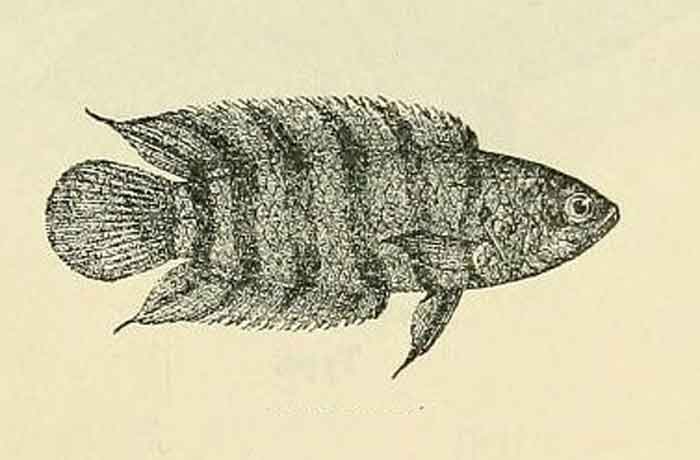
Superregnum: Eukaryota
Cladus: Unikonta
Cladus: Opisthokonta
Cladus: Holozoa
Regnum: Animalia
Subregnum: Eumetazoa
Cladus: Bilateria
Cladus: Nephrozoa
Superphylum: Deuterostomia
Phylum: Chordata
Subphylum: Vertebrata
Infraphylum: Gnathostomata
Megaclassis: Osteichthyes
Superclassis/Classis: Actinopterygii
Classis/Subclassis: Actinopteri
Subclassis/Infraclassis: Neopterygii
Infraclassis: Teleostei
Megacohors: Osteoglossocephalai
Supercohors: Clupeocephala
Cohors: Euteleosteomorpha
Subcohors: Neoteleostei
Infracohors: Eurypterygia
Sectio: Ctenosquamata
Subsectio: Acanthomorphata
Divisio/Superordo: Acanthopterygii
Subdivisio: Percomorphaceae
Series: Anabantaria
Ordo: Anabantiformes
Subordo: Anabantoidei
Familia: Anabantidae
Genus: Microctenopoma
Species: Microctenopoma ansorgii
Name
Microctenopoma ansorgii (Boulenger, 1912)
Syntypes: ANSP 38655-38658 (4), BMNH 1912-4-1:480-487 (8), MRAC 1703-1704 (2), MRAC 1705-1708 (4)
Type locality: Lagoons near Luali River at Lundo, Lower Congo.
Etymology: This species was named in honor of Dr. Ansorge.
Synonyms
Anabas ansorgii Boulenger, 1912
Anabas ansorgei Boulenger, 1912
Ctenopoma ansorgii (Boulenger, 1912)
Ctenopoma ansorgei (Boulenger, 1912)
Microctenopoma ansorgei (Boulenger, 1912)
Anabas davidae Poll 1939
Ctenopoma davidae (Poll, 1939)
References
Primary references
Boulenger, G.A. 1912. Poissons recueillis dans la Région du Bas-Congo par M. le Dr W. J. Ansorge. Poissons, Batraciens et Reptiles. (Matériaux pour la Faune du Congo.). Annales du Musée du Congo Belge, Sér. C (Zoologie) (Sér. 1) 2(3): 1–27, Pls. 17-22. Reference page.
Additional references
Böhlke, E.B. 1984. Catalog of type specimens in the ichthyological collection of the Academy of Natural Sciences of Philadelphia. Special publication (Academy of Natural Sciences of Philadelphia) No. 14: i–viii + 1–216. Reference page.
Gosse, J.-P., 1986. Anabantidae (pp. 402-414). In: Daget, J., J.-P. Gosse and D.F.E. Thys van den Audenaerde (eds), 1986. Check-list of the freshwater fishes of Africa. CLOFFA. ISNB Bruxelles, MRAC Tervuren, ORSTOM Paris. v. 2: i-xiv + 1-520. PDF
Norris, S.M. 1995. Microctenopoma uelense and M. nigricans, a new genus and two new species of anabantid fishes from Africa. Ichthyological Exploration of Freshwaters v. 6 (no. 4): 357-376.
Norris, S.M., 2007. Anabantidae (pp. 251-268). In: Stiassny, M.L.J., G.G. Teugels & C.D. Hopkins (eds), 2007. The Fresh and Brackish Water Fishes of Lower Guinea, West-Central Africa. [Poissons d'eaux douces et saumâtres de basse Guinée, ouest de l'Afrique centrale.] Faune et flore tropicales. Publications scientifiques du Museum, MRAC. Vol. 2: 603 pp.
Poll, M., 1939. Les poissons du Stanley-Pool. Annales du Musée du Congo Belge Sér C (Zoologie: Poissons, reptiles, amphibies) (Sér. 1) v. 4 (no. 1): 1-60. (Anabas davidae)
Links
Microctenopoma ansorgii in FishBase,
Froese, R. & Pauly, D. (eds.) 2024. FishBase. World Wide Web electronic publication, www.fishbase.org, version 02/2024, accessed on April 05, 2022.
Microctenopoma ansorgii in Catalog of Fishes, Eschmeyer, W.N., Fricke, R. & van der Laan, R. (eds.) 2024. Catalog of Fishes electronic version, accessed on April 05, 2022.
Microctenopoma ansorgii – Taxon details on Integrated Taxonomic Information System (ITIS).
Microctenopoma ansorgii – Taxon details on National Center for Biotechnology Information (NCBI).
IUCN: Microctenopoma ansorgii (Least Concern)
Microctenopoma ansorgii in the World Register of Marine Species, accessed on April 05, 2022
Vernacular names
English: Ornate ctenopoma
polski: Buszowiec Ansorga
українська: Ктенопома Анзорга
Tiếng Việt: Cá rô vàng
Microctenopoma ansorgii is a small freshwater fish, known in the aquarium trade as the ornate ctenopoma, orange ctenopoma, ornate climbing perch, pretty ctenopoma, or rainbow ctenopoma. It is related to the more familiar spotted climbing perch (Ctenopoma acutirostre), but looks very different.[2] Its body is more elongated and rounded, with fins with red and black stripes; the color intensifies when the fish are displaying, with black bars becoming visible on the body. The ornate ctenopoma spawns at night, laying its eggs on a floating bubble nest like its relatives in the osphronemidae. It lives in the slow-flowing forest streams of the Congo Basin, where it feeds on worms, insect larvae, and other aquatic invertebrates.[3] It is the most common member of its genus in the aquarium trade, where it is known for being a shy, easily bullied fish that needs live or frozen foods and which benefits from the presence of smaller dither fish to encourage it to come out of hiding.[4][5]
This species was described by George Albert Boulenger in 1912 from a type locality of some lagoons near Luali River at Lundo in the Democratic Republic of Congo.[6] The collector of the type, the explorer William John Ansorge (1850-1913).[7]
References
Moelants, T. (2010). "Microctenopoma ansorgii". IUCN Red List of Threatened Species. 2010: e.T181678A7703128. doi:10.2305/IUCN.UK.2010-3.RLTS.T181678A7703128.en. Retrieved 20 November 2021.
Steven M. Norris, Michael E. Douglas. A New Species of Nest-building Ctenopoma (Teleostei, Anabantidae) from Zaire, with a Redescription of Ctenopoma lineatum (Nichols) Copeia, vol. 1991, no. 1 (Feb. 7, 1991), pp. 166–178 doi:10.2307/1446261
*Froese, Rainer; Pauly, Daniel (eds.) (2008). "Microctenopoma ansorgii" in FishBase. September 2008 version.
"Microctenopoma ansorgii (Ornate ctenopoma) — Seriously Fish".
"Keeping and breeding Microctenopoma ansorgii - AquaInfo".
Eschmeyer, William N.; Fricke, Ron & van der Laan, Richard (eds.). "Anabas ansorgii". Catalog of Fishes. California Academy of Sciences. Retrieved 12 December 2019.
Christopher Scharpf; Kenneth J. Lazara (21 October 2019). "Order ANABANTIFORMES: Families ANABANTIDAE, HELOSTOMATIDAE, OSPHRONEMIDAE, CHANNIDAE, NANDIDAE, BADIDAE, and PRISTOLEPIDIDAE". The ETYFish Project Fish Name Etymology Database. Christopher Scharpf and Kenneth J. Lazara. Retrieved 10 December 2019.
Retrieved from "http://en.wikipedia.org/"
All text is available under the terms of the GNU Free Documentation License

